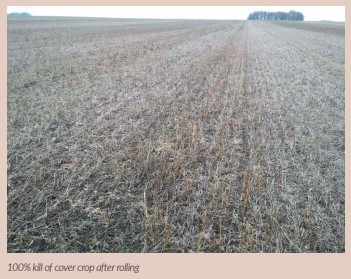
Following directly on from my January ramblings , I was lucky enough to have a couple of frosty nights in early Feb which allowed me to roll 30 Ha of cover crops with our 10 m roll on the controlled traffic wheelings. I got pretty well 100% kill on everything rolled in the early hours before the temperature climbed above about minus 2. The later areas rolled after daybreak did not fully die back and I had to reroll them on the next (and last!) frost of the season to finish the job off.
After thinking for the last few seasons that I was getting negative effects in spring barley following grazed cover crops it was useful to be able to compare the two scenarios properly.The spring barley on both grazed and ungrazed blocks was from the same batch of seed drilled at the same time and the same seedrate with the dale drill.Establishment was approximately 50-60% in the grazed fields and 70-75% in the ungrazed fields and the crop on the ungrazed block has grown away better . I will be surprised if the yield is not significantly higher ( will report back in due course after harvest )

Going forwards I am now thinking that fields destined for spring barley will be subsoiled straight behind the combine and then immediately sown with frost susceptible cover which will not be grazed and will be direct drilled into good soil conditions after frost/glyphosate destruction. I can hear all the die hard “regen aggers” screaming what about livestock integration but luckily you will all be pleased to hear that I still see a need for livestock integration but maybe grazing winter cereals rather than cover crops. For a number of years we have experimented fencing small areas in Winter Barley fields and mob stocking them sheep for a few days . Results have been favourable in that the crop has had less disease through the season and has ended up shorter at harvest time ( good for us as we plant OSR into chopped Winter Barley straw so don’t want much of it ! )
Unfortunately, the areas involved have never been large enough to get accurate yield data from the combine to see whether yield is affected. This year we have grazed a much bigger area alongside ungrazed in the same field so should be able to get yield data. (NIABTAG were involved in a similar trial grazing wheat and sent leaves away for disease inoculum testing which showed massive reductions in Septoria and yellow rust infection in the grazed areas )

My thinking is that the most appropriate place to use sheep may be in this winter cereal grazing scenario , giving a number of possible benefits : -Reducing disease inoculum -reducing growth regulator use – no detrimental effect on establishment ( like we are seeing in spring barley after grazed covers ) as crop already established before grazing -possibly allows crops to be drilled earlier in September in good soil conditions and then use sheep grazing to obtain benefits of later drilling by removing pretty well all above ground leaf area and hence reduce Septoria and BYDV problems????
I am afraid my penchant for collecting drills is continuing .Following on from my thoughts in my last article we have ordered an Horizon disc drill complete with row cleaners to hopefully prevent the bad hair pinning we have previously experienced when using disc drills.
We have also purchased a Weaving IR drill to fulfil a large annual contract we have got undersowing maize with grass seed. Looking at the drill has also given me an idea for experimenting with it to sow inter row cover crops/clover understoreys in winter wheat in late spring. It already has a spare air outlet on the distribution head and with the purchase of one extra coulter we could space the units at 25cm to match a 6m drill planting cereals at 25cm row spacing. ( presently have the Horizon ordered on 20cm row spacings but wonder if I should be re-thinking that?? )

Moving to wider issues I am concerned that the current worldwide food crisis is starting to trigger comments in the media that UK agriculture should be binning environmental works and concentrating on out and out food production as if the two things were mutually exclusive.
I have an analogy that I like to use: Industrial businesses that have a production process housed in factory premises make their profit from goods rolling off their production line. They then divert some of their profit to maintaining the factory premises .They do this without grants or subsidies or inducements because it is obviously good business sense to ensure the roof doesn’t cave in and destroy the production process. Similarly Agriculture is working within natural ecosystems that I see as the “Factory premises” For too long industrial agriculture has concentrated on the food production line and ignored the “factory premises” The reality is that we should all be prepared to divert profits towards “Factory maintenance” whether or not we are being paid by DEFRA to do so .( Hard Hat on ! )

We are trying quite hard to carry out “factory maintenance” at Hendred Estate.One of our efforts is to try to bring as much diversity and habitats onto the farm to sit alongside profitable crop production.We have experimented for a number of years with companion cropping and clover understoreys but have found that there are a lot of practical problems and I am struggling to see how to roll these techniques out on a large scale at the moment. ( Although I applaud the hard work people like Andy Howard and others are doing to make these cropping systems more economically viable )
What we are doing is trying to bring habitats and diversity into fields by planting wildflower strips within fields. To further enhance these strips we have planted an experimental area within one north /south strip with Native hedging and Hazel coppice as a type of Agroforestry system. This should stretch the availability of pollen and nectar for beneficials as well as providing more habitat and carbon capture.